
Making It Right in the Lower 9th Ward
Six Louisiana homes that achieved notable green building certifications from the U.S. Green Building Council and National Association of Home Builders are located in the Lower 9th Ward of New Orleans. That wasn’t the case prior to August 2005 when Hurricane Katrina devastated the historic neighborhood, but due to the restoration efforts of actor Brad Pitt’s Make It Right Foundation (MIR), the community is being rebuilt with uniquely designed homes that are affordable, safe and green.
At the onset of the 2009 Codes Forum Field Activity for Green Building and When Disaster Strikes, MIR Executive Director Tom Darden explained to delegates that the foundation for the organization’s rebuilding effort was formed through partnerships with displaced neighborhood residents and six months of meetings to determine their needs. In addition to bringing the residents home, MIR decided to confront other challenges that plagued the low-income households prior to Hurricane Katrina such as rising energy costs and deteriorating environmental conditions. “Our goal was to build it better than what they had before,” Darden said.
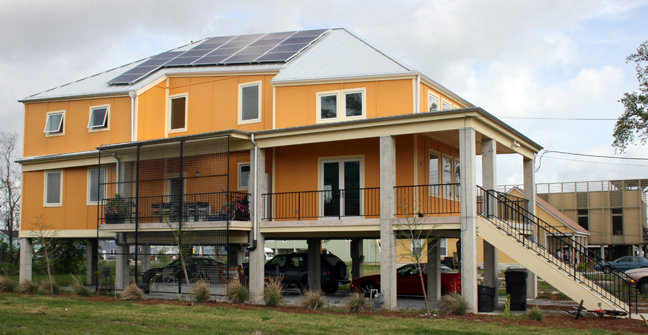
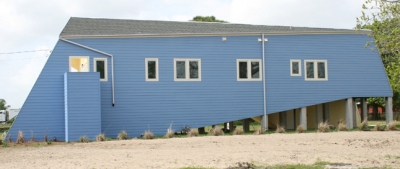
Architectural designs of the Make It Right Foundation homes vary, but meet the criteria of affordability, safety and sustainability.
Working in cooperation with the Unified New Orleans Plan, MIR launched its goal of building 150 safe and healthy homes that are environmentally friendly, with an emphasis on high-quality design while preserving the rich culture of the community. MIR reached out to 13 architectural firms that accepted the volunteer challenge of designing innovative, 1,400-square-foot homes that could serve as models for similar rebuilding projects in the future. “Another goal was, ‘If we could figure out how to build it here, we could build it anywhere,” Darden said.
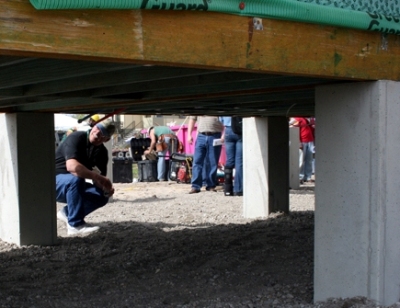
The Make It Right Foundation homes feature mitigation measures such as impact-resistant doors and windows and an elevation of at least five feet to accommodate a high-water event.
The architectural designs vary, but meet the MIR criteria of affordability, safety and sustainability, and require mitigation measures such as impact-resistant doors and windows and an elevation of at least five feet to accommodate a high-water event. The homes feature energy and water-saving technologies, infrastructure materials and advanced framing techniques, and are equipped with sustainable items such as solar energy panels and groundwater heat pumps. The homes even have separate plumbing lines for rain harvesting systems in case a state law banning the use of rainwater for toilets is repealed.
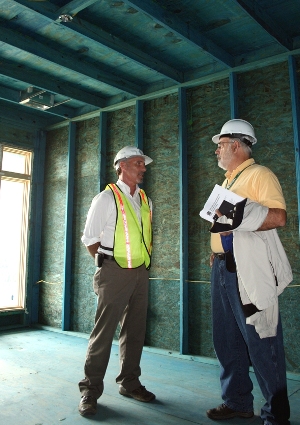
The Make It Right Foundation homes also feature energy and water-saving technologies, infrastructure materials and advanced framing techniques.

During the Field Activity in the Lower 9th Ward, Codes Forum delegates toured the construction sites of another nine MIR homes that are being built with storm-resistant and energy-efficient practices. Code Council Senior Vice President of Member Services and Communications Mike Armstrong said the tour served as a perfect laboratory for the Codes Forum’s education courses on green building, energy efficiency and post-disaster rebuilding. "Green concepts and what we call sustainability practices are changing and evolving so rapidly,” Armstrong told reporters during a media event at the construction sites. “We think there is good information to be gathered moving forward that could be helpful in a discussion about where do we go now.”
Delegates were provided Standard for Residential Construction in High-Wind Areas and National Green Building Standard checklists that showed how the various design and building methods were compliant with the new standards. MIR Project Architect Sarah Howell overviewed green products that are being used in the construction—foam insulation, pervious concrete and recycled concrete columns, Energy Star cool roofs and lighting, insulated glass windows—to help achieve the goal of reducing individual homes’ energy use by 75 percent. She noted that many of the products currently have Evaluation Reports through the ICC Evaluation Service, and that residents are already reaping the benefits. “Some of our homeowners are reporting energy bills as low as $20-25 per month, and that’s amazing,” Howell said.
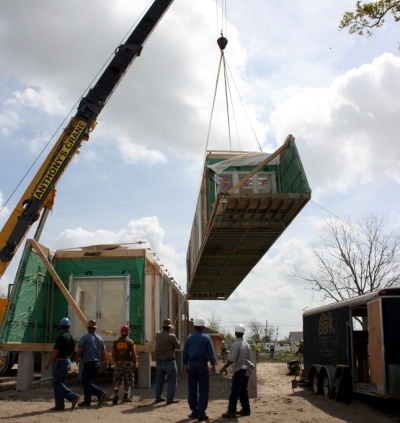
Some of the Make It Right Foundation homes are modular and have environmentally friendly features such as Steel SIPs and ECO Panels. "The whole shell of the building goes up in one day," explained MIR Project Architect Sarah Howell. "This is really an efficient system."
MIR Construction Director Jon Sader said finding contractors who were qualified to build the unique MIR homes was initially a challenge. “When we started, we couldn’t find anyone in New Orleans who knew how to build green—or at least they didn’t come to us,” he said. “Today, we have six green contractors.” As the MIR project has evolved along with the green building industry, Sader said the sustainable designs and construction stood up to the forces of nature when Hurricane Gustav made landfall in 2007. “Not one window was broken,” he added. Sader, a third-generation contractor from Michigan who entered New Orleans as soon as Katrina’s floodwaters receded, said the benefits of building back sustainable and green in areas devastated by disasters could have a lasting impact on the future. “The cure for cancer may not lie in a hospital, but with the carcinogens in our homes,” he said.
Armstrong said onsite laboratories such as the one in the Lower 9th Ward of New Orleans can be beneficial to the Code Council’s initiatives in safe and sustainable building. “We want our members to look at these buildings, ask questions, look at the materials, and examine how these materials and practices can be replicated around the country,” he told media members. “During (the code development process), it could occur that we have recommendations to enhance our energy conservation codes or add other codes, so I think the more information we can give our members through these field trips and the more they can learn, the better informed we'll be.”
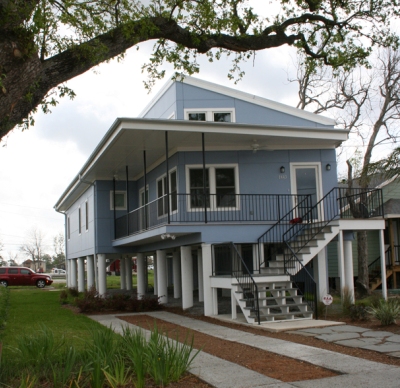
In addition to bringing the Lower 9th Ward residents home, Make It Right Foundation volunteers decided to confront other challenges that plagued the low-income households prior to Hurricane Katrina. "Our goal was to build it better than what they had before," MIR Executive Director Tom Darden said.
To date, the Make It Right Foundation has raised funds to construct 91 of the planned 150 homes in the Lower 9th Ward. For more information, go to http://www.makeitrightnola.org/.
Home | Membership | ICC Store | Codes & Standards | Government Relations
Training | Certification & Testing | Public Safety | Jobs & Code Talk | Newsroom & Magazine | Contact Us | Privacy Policy
Subsidiaries: ICC Evaluation Service | International Accreditation Service | ICC Foundation
© 2009 International Code Council